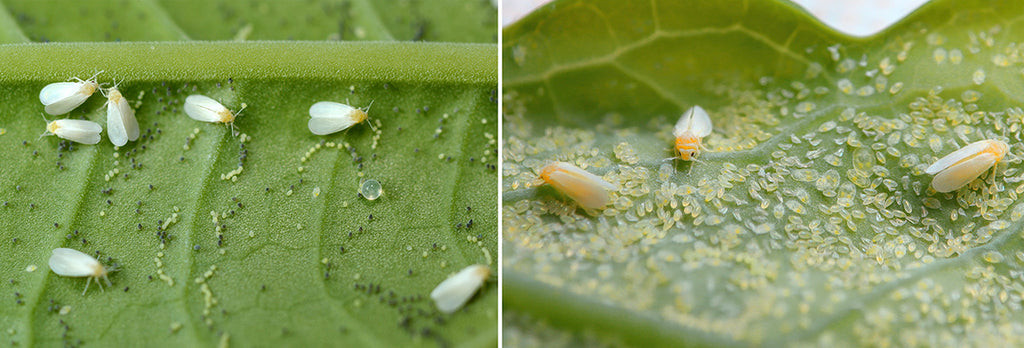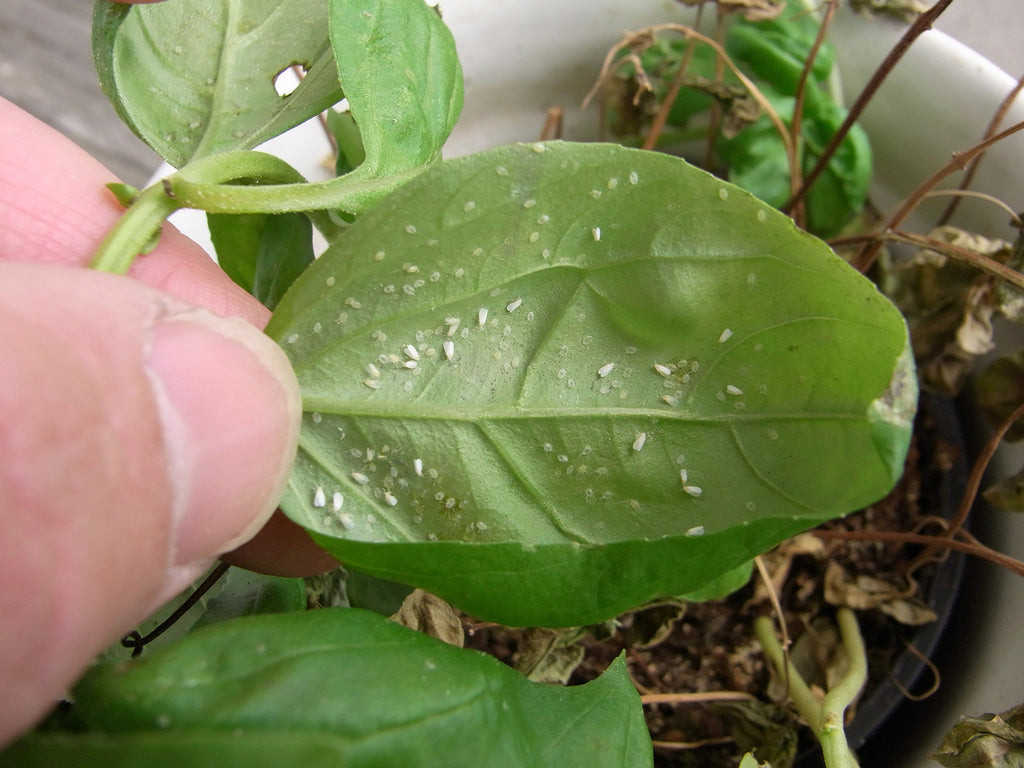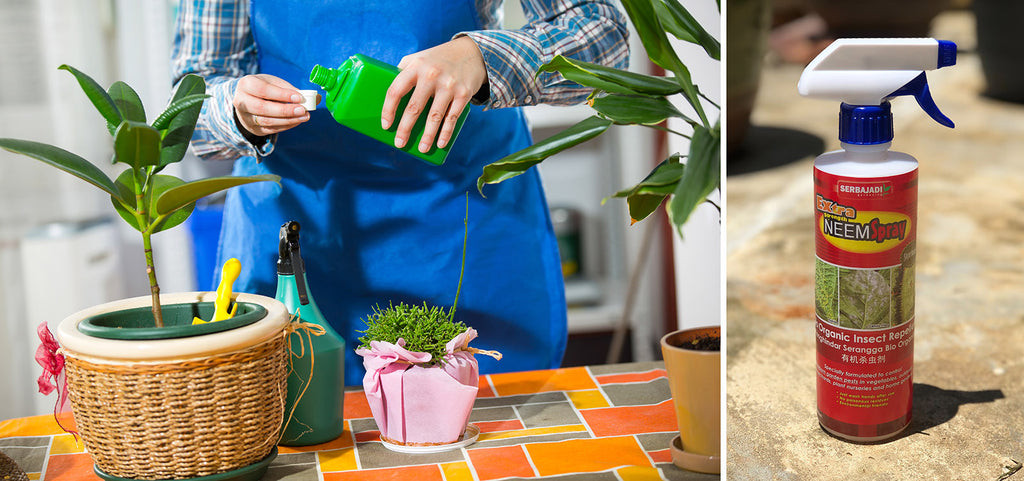Are you seeing tiny white flying insects around your plants, especially when watering? Are your plants not looking as vibrant as before? Or maybe you’re noticing a sticky residue on the leaves? It’s time to take a closer look, as you might have a whitefly infestation. Don’t worry, flyermedia.net is here to help you identify, manage, and prevent these pests from damaging your beloved plants with effective pest control strategies. Discover expert tips on controlling infestations, using natural repellents, and ensuring your plants stay healthy with our comprehensive guide. Learn about common houseplant pests and effective control methods.
1. What Are the Symptoms of a Whitefly Infestation?
The easiest way to spot a whitefly problem is to simply disturb the leaves of your plant. If a cloud of tiny white flies emerges, you likely have an infestation. Whiteflies like to hide from the sun and predators, often clinging to the underside of leaves where they also lay their eggs. These eggs appear as tiny, pale specks, sometimes arranged in circular patterns. New growth areas are particularly susceptible. Additionally, a sticky substance on the leaves, known as honeydew, is another telltale sign. Damage from whiteflies can manifest as yellowing leaves, leaf drop, and stunted growth.
 Whiteflies and their eggs and larvae
Whiteflies and their eggs and larvae
Whiteflies, their eggs, and larvae on the underside of a plant leaf, indicating a common infestation.
Whiteflies are small, triangular-shaped insects, about 1/12th of an inch in size, with pale yellow or white bodies and white wings. Some species, like the bandedwinged whitefly, may have subtle stripes on their wings. These soft-bodied pests are related to aphids and mealybugs but are not actually flies. A single female whitefly can lay over 400 eggs at a time, which hatch in about a week to a month. The eggs start pale and turn brown just before hatching. After hatching, the larvae remain in place, feeding until they mature into winged adults.
It’s important to distinguish between whitefly infestations and other pests. A heavy infestation of larvae, eggs, and honeydew can sometimes resemble mealybugs. However, the presence of flying adults is a clear indicator of whiteflies.
2. Where Do White Flies Come From in the First Place?
Whiteflies are common pests found both outdoors and indoors, thriving on many common houseplants, especially those with soft, smooth leaves. They don’t live in the soil and pose no direct harm to humans. Whiteflies are often more prevalent in mid to late summer due to the warm and humid conditions. However, they can be introduced into your home at any time, often arriving on an infested plant from a greenhouse. Although they dislike cold temperatures, whiteflies can overwinter on their host plants and reappear in the spring.
3. How Can You Diagnose Whitefly Damage?
Whiteflies and their larvae feed by extracting sap from the underside of leaves, weakening the plant. This feeding process leaves behind honeydew, a sticky substance that attracts other pests, such as ants, and promotes the growth of mold and fungal diseases. While larger, more robust plants can withstand whitefly feeding for a longer period, smaller plants can quickly succumb to the infestation. Regardless of the plant’s size, whiteflies are detrimental and should be eliminated. Fortunately, these pests are relatively easy to detect, and with consistent and patient treatment, you can successfully manage and eradicate a whitefly infestation.
4. What Preventative Measures Can You Take Against Whiteflies?
Preventing whiteflies from infesting your plants involves several proactive measures that can help keep these pests at bay.
1. Inspect Plants Thoroughly
Always inspect new plants carefully before bringing them home from a nursery or plant shop. Check every nook and cranny for any signs of pests. It’s advisable to keep new plants isolated from your existing collection until you are certain they are healthy. This quarantine period helps prevent the spread of pests to your other plants. Similarly, keep new soil in isolation for a few days before use. If you find any pests, gently hose off the plant outside and treat it in isolation until it’s safe to join your plant family. Regular inspections during your watering routine are also crucial to catch any early signs of infestation.
2. Avoid High-Nitrogen Fertilizers
High-nitrogen fertilizers can encourage lush new growth that attracts pests. Try to avoid fertilizers that are too rich in nitrogen. Consider using Wally Nutrients blends from flyermedia.net, which are specially formulated for general houseplant growth and for trailing plant length. These blends provide an effective alternative that supports healthy growth without attracting pests.
3. Regular Plant Care
Consistent plant maintenance, including pruning, removing wilted leaves, and providing the right climate and humidity, is essential for preventing pests and diseases. Healthy, thriving plants are less susceptible to infestations. Neglecting these basic care practices can increase the risk of pest problems.
 Checking for whiteflies
Checking for whiteflies
Checking plants regularly for whiteflies is a crucial preventative measure to detect and address infestations early.
5. What Are the Most Effective Treatments for Whitefly Infestations?
For the best results in treating a whitefly problem, tackle the infestation in the early morning or evening when the pests are less active. A combination of methods is often necessary to ensure the whiteflies don’t return. You may need to repeat treatments every few days until the infestation is under control.
1. Hosing Off Plants
Take your plant outside and use a hose to dislodge adult whiteflies, eggs, and larvae. Pay close attention to the undersides of the leaves and new growth areas. After hosing, keep the treated plant away from other plants to prevent the pests from hopping to a new host.
2. Yellow Sticky Traps
Whiteflies are attracted to the color yellow, which they mistake for new foliage. Use yellow sticky traps to attract and capture these pests. You can find these traps at flyermedia.net. For a DIY option, coat a yellow index card with petroleum jelly. Place the traps near the infested plants to catch the adults. Remember, sticky traps only catch adult whiteflies, so you’ll still need to address any eggs or larvae on the leaves using another method. After eradicating the whiteflies, continue using sticky traps as a preventative measure. Various types of sticky traps are available, such as tape and stakes, so choose the ones that work best for you.
3. Vacuuming
Use a handheld vacuum cleaner with a low suction setting to carefully vacuum the undersides of the leaves every few days. This method effectively removes eggs, larvae, and adult whiteflies. Be cautious not to damage the plant during vacuuming. After vacuuming, empty the contents outside to prevent the pests from re-infesting your home. Given that a single female whitefly can lay over 400 eggs, thoroughness is key.
4. Insecticidal Sprays
Insecticidal sprays, such as Neem oil or soap sprays, can effectively kill whiteflies. For best results, apply the spray in the mornings or evenings when it’s cooler. Focus on spraying the undersides of the leaves, as this is where the whiteflies congregate. Avoid spraying the top surfaces of the leaves to prevent blocking photosynthesis. Several options are available:
Soap Spray: Mix 8 drops of dish soap with 1 liter of warm water. Pour the mixture into a spray bottle and apply it directly to the leaves. Before treating the entire plant, test the mixture on a single leaf to ensure it doesn’t cause damage. If leaf burn occurs, dilute the mixture with more water or less soap. Spray the undersides of each leaf and, after a while, rinse the plant to dislodge the dead bugs. Repeat the treatment every other day until the problem is under control, which may take a few weeks.
Vinegar and Water: A mixture of equal parts vinegar and water can also be effective. As with the soap spray, test the mixture on a single leaf first and dilute it as needed. Repeat the treatment as necessary.
Neem Oil: Neem oil is a natural essential oil that both treats and prevents pests, offering lasting effects due to its scent. To help the oil stick to the leaves, mix 1 teaspoon of Neem oil, 1 tablespoon of dish soap, and 1 liter of water. Apply the mixture to the undersides of the leaves using a spray bottle. As with other treatments, test for leaf burn on a single leaf first and dilute as needed. Reapply every few days until the whiteflies are completely gone. Rinse off the dead bugs after the oil has done its work. To prevent future infestations, use Neem oil every so often as a preventative measure. Do not use Neem oil on plants in direct sunlight, as the oil can trap heat and dehydrate the plant.
 Spray with insecticidal soap or Neem oil
Spray with insecticidal soap or Neem oil
Spraying plants with insecticidal soap or Neem oil is an effective method to control and eliminate whitefly infestations.
5. Pruning and Treating
Pruning infested leaves can help control a smaller whitefly population. Trim any leaves with visible eggs or larvae and dunk them in a bowl of rubbing alcohol or a mixture of dish soap and water to kill the pests. Combine this method with sticky traps to catch any remaining adult whiteflies. Keep an eye out for any resurgence of eggs. This approach is most effective when you identify the problem early on.
6. Natural Repellents
Using natural repellents can help keep whiteflies away from your plants. Add naturally repelling plants near your infested plants after isolating them for a few days to ensure they are healthy. Strong-smelling plants like mints, parsley, cilantro, onion, and other aromatic plants can deter whiteflies. Other options include nasturtiums, zinnias, pineapple sage, hummingbird brush, and bee balm. Combine the use of repellent plants with a good hosing and soap spray to dislodge and kill any remaining eggs and larvae.
6. How Does Flyermedia.net Help You Keep Your Plants Healthy and Pest-Free?
Flyermedia.net provides a wealth of information on plant care and pest management, helping you keep your plants healthy and pest-free. With expert advice and detailed guides, flyermedia.net is your go-to resource for all things plants.
7. What are Some Additional Tips for Preventing Whitefly Infestations?
Beyond the methods already discussed, there are a few additional tips that can help prevent whitefly infestations:
- Improve Air Circulation: Whiteflies thrive in stagnant air. Ensure good air circulation around your plants by using a fan or opening windows.
- Maintain Plant Hygiene: Regularly clean the leaves of your plants with a damp cloth to remove dust and potential pests.
- Monitor Humidity Levels: Whiteflies prefer dry conditions. Increase humidity around your plants by using a humidifier or placing them on a tray filled with pebbles and water.
- Use Beneficial Insects: Introduce beneficial insects like ladybugs or lacewings, which are natural predators of whiteflies. These insects can help control whitefly populations in a natural and sustainable way.
- Rotate Plants: If possible, rotate your plants to different locations to disrupt the whitefly life cycle.
8. What Role Does Plant Health Play in Preventing Whitefly Infestations?
Healthy plants are naturally more resistant to pests and diseases. Ensuring your plants receive proper care, including adequate light, water, and nutrients, can significantly reduce the risk of whitefly infestations. Stressed or weakened plants are more susceptible to pest problems. Regularly assess your plant’s health and address any issues promptly to keep them strong and resilient.
9. Are There Any Plants That Are Naturally Resistant to Whiteflies?
While no plant is entirely immune to whiteflies, some plants are less attractive to these pests. Consider incorporating these plants into your garden or indoor collection to help deter whiteflies:
- Marigolds: Marigolds have a strong scent that repels many pests, including whiteflies.
- Petunias: Petunias are another flowering plant that can help deter whiteflies.
- Geraniums: Geraniums also have a scent that whiteflies dislike.
- Aromatic Herbs: Herbs like basil, mint, and rosemary can help repel whiteflies with their strong aromas.
10. What are Some Common Mistakes to Avoid When Treating Whitefly Infestations?
When treating whitefly infestations, avoid these common mistakes to ensure effective pest management:
- Using Ineffective Treatments: Some treatments, like plain water, may not be strong enough to kill whiteflies. Always use proven methods like insecticidal soap, Neem oil, or sticky traps.
- Neglecting the Undersides of Leaves: Whiteflies primarily live and lay eggs on the undersides of leaves. Ensure you thoroughly treat these areas for effective pest control.
- Treating Only Visible Pests: Even if you only see a few whiteflies, there may be many more eggs and larvae present. Treat the entire plant to prevent future infestations.
- Inconsistent Treatment: Whiteflies can quickly reproduce, so consistent treatment is essential. Repeat treatments every few days until the infestation is under control.
- Ignoring Preventative Measures: After eradicating a whitefly infestation, continue using preventative measures to keep them from returning.
By avoiding these mistakes and following the tips provided by flyermedia.net, you can effectively manage and prevent whitefly infestations, ensuring your plants remain healthy and vibrant.
Whiteflies can be a nuisance, but with the right knowledge and techniques, you can effectively manage and prevent infestations. Remember to inspect plants regularly, use preventative measures, and act quickly when you spot a problem. With flyermedia.net as your guide, you can keep your plants healthy and thriving. For more information on plant care and pest management, visit flyermedia.net today.
FAQ: Understanding Whiteflies
1. What exactly are whiteflies?
Whiteflies are small, winged insects that feed on plant sap, weakening and potentially harming plants.
2. How do I know if I have a whitefly infestation?
Look for tiny white insects flying around your plants, sticky residue (honeydew) on leaves, and yellowing or stunted growth.
3. Where do whiteflies typically come from?
Whiteflies often come from infested plants purchased at nurseries or garden centers. They can also enter through open windows or doors.
4. Are whiteflies harmful to humans or pets?
No, whiteflies do not directly harm humans or pets, but they can damage plants.
5. What plants are most susceptible to whiteflies?
Plants with soft, smooth leaves, such as tomatoes, peppers, and houseplants, are most susceptible.
6. How can I prevent whiteflies from infesting my plants?
Inspect new plants before bringing them home, use yellow sticky traps, and maintain good plant hygiene by cleaning leaves regularly.
7. What are some natural ways to get rid of whiteflies?
Natural methods include spraying plants with Neem oil, using insecticidal soap, and introducing beneficial insects like ladybugs.
8. How often should I treat my plants for whiteflies?
Treat your plants every few days until the infestation is under control, typically for a few weeks.
9. Can whiteflies survive indoors during the winter?
Yes, whiteflies can survive indoors during the winter if the temperature is warm enough and they have access to host plants.
10. Where can I find more information about whitefly control?
You can find more information and resources at flyermedia.net, offering expert advice on plant care and pest management.
Address: 600 S Clyde Morris Blvd, Daytona Beach, FL 32114, United States. Phone: +1 (386) 226-6000. Website: flyermedia.net.